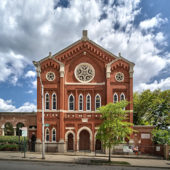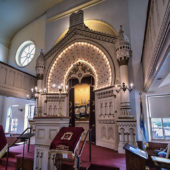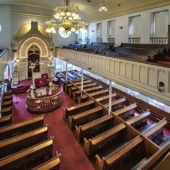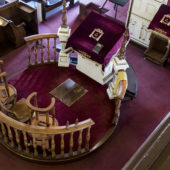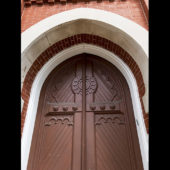Architecturally an eclectic blend of Gothic, Moorish and Romanesque styles, the historic building is located in central Baltimore.
B’nai Israel is one of two synagogues on the Jewish Museum of Maryland campus, the other being the Lloyd Street Synagogue.
Congregation B’Nai Israel incorporated in 1873 as the “Russian Congregation B’nai Israel of Baltimore City”. It was established by Eastern European Jews living in a center of Jewish Baltimore along the Jones Falls River. In 1895 B’Nai Israel purchased its current synagogue building from the Chizuk Amuno congregation which moved further west.
The Chizuk Amuno congregation was formed in 1870 by a group who were dissatisfied with the reforms introduced at Baltimore’s Lloyd Street Synagogue. In 1874 they purchased a lot just south of the Lloyd Street Synagogue. To build a synagogue on the lot they hired amateur architect Henry Burge, a non-Jewish immigrant from Bavaria.
The synagogue’s design is eclectic combining Moorish, Romanesque and Gothic styles. Moorish style horseshoe arches frame the three exterior front entrance doorways. The pointed arch windows are distinctly Gothic while the large central rose window shows Byzantine influence.
The focal points of the interior are the hand-carved Ark projecting from an apse on the Eastern wall and the bimah in the center of the sanctuary. The elaborate wooden Ark, with marble tablets above, is trimmed with gold paint to further accentuate its edges. This imposing Ark, which took two years to complete, was handmade by a Mr. Yeager. For his efforts Mr. Yeager received $77! Above and in back of the Ark there are two circular windows that were stained glass before their destruction by vandals.
The large central chandelier was installed around 1889. This made-to-order fixture has upward facing gas lights and downward facing electric lights. The electric lights were added in 1915.

